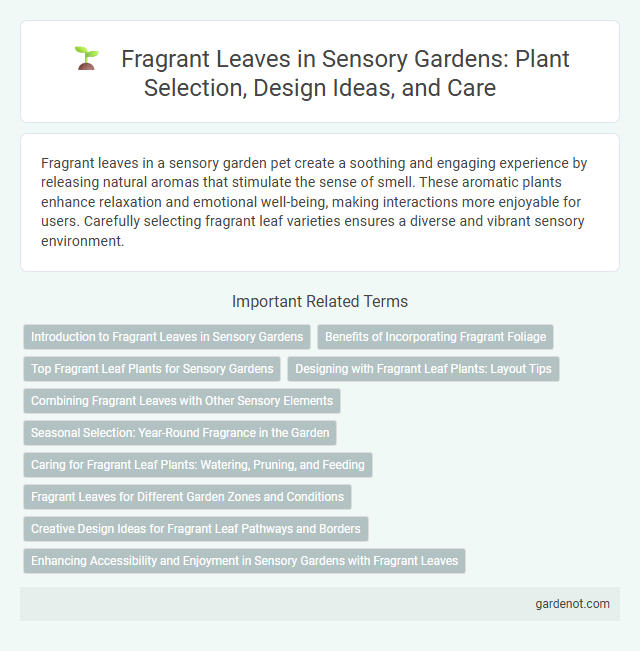Fragrant leaves in a sensory garden pet create a soothing and engaging experience by releasing natural aromas that stimulate the sense of smell. These aromatic plants enhance relaxation and emotional well-being, making interactions more enjoyable for users. Carefully selecting fragrant leaf varieties ensures a diverse and vibrant sensory environment.
Introduction to Fragrant Leaves in Sensory Gardens
Fragrant leaves in sensory gardens provide an aromatic experience that engages the olfactory senses and enhances emotional well-being. Popular plants like lavender, lemon balm, and scented geraniums release essential oils when touched, encouraging interaction and sensory exploration. These aromatic foliage varieties contribute to a calming atmosphere and promote mindfulness within therapeutic gardening environments.
Benefits of Incorporating Fragrant Foliage
Incorporating fragrant foliage in a sensory garden enhances the multisensory experience by stimulating olfactory senses, promoting relaxation, and improving mood. Plants such as lavender, mint, and rosemary release natural aromatic compounds that can reduce stress and increase mental clarity. These fragrant leaves also attract pollinators, supporting biodiversity and creating a dynamic, eco-friendly garden environment.
Top Fragrant Leaf Plants for Sensory Gardens
Top fragrant leaf plants for sensory gardens include lavender, rosemary, and scented geraniums, known for their aromatic foliage that enhances sensory experiences. These plants release essential oils when touched or brushed against, stimulating the sense of smell and providing therapeutic benefits. Incorporating fragrant leaf plants creates a multi-sensory environment ideal for relaxation, memory stimulation, and sensory exploration.
Designing with Fragrant Leaf Plants: Layout Tips
Incorporate fragrant leaf plants such as lavender, rosemary, and lemon balm to create a multisensory experience in sensory garden layouts. Position these aromatic plants along pathways and near seating areas to maximize scent exposure and enhance relaxation. Grouping varieties with complementary fragrances boosts olfactory stimulation while ensuring easy maintenance and seasonal interest.
Combining Fragrant Leaves with Other Sensory Elements
Fragrant leaves enrich sensory gardens by adding aromatic experiences that enhance the overall environment. Combining these leaves with tactile elements such as textured plants and auditory features like rustling grasses creates a multi-sensory landscape that engages sight, smell, touch, and sound. This integration supports therapeutic benefits and deepens visitor connection to nature through layered sensory stimulation.
Seasonal Selection: Year-Round Fragrance in the Garden
Fragrant leaf plants provide a dynamic sensory experience with their seasonal selection, ensuring year-round fragrance in the garden. Varieties such as lavender, rosemary, and scented geraniums offer distinct aromatic profiles that change with the seasons, enhancing the garden's appeal throughout the year. Incorporating these plants creates a continuously fragrant environment, stimulating the senses and promoting relaxation irrespective of the time of year.
Caring for Fragrant Leaf Plants: Watering, Pruning, and Feeding
Fragrant leaf plants in sensory gardens thrive with consistent watering to maintain moist, well-drained soil, preventing both desiccation and root rot. Regular pruning encourages bushier growth and enhances the plant's aromatic properties by removing dead or overgrown stems. Feeding these plants with a balanced fertilizer during the growing season supports vibrant foliage and sustained fragrance intensity.
Fragrant Leaves for Different Garden Zones and Conditions
Fragrant leaves such as lavender, rosemary, and scented geraniums thrive in well-drained, sunny garden zones, providing aromatic appeal and enhancing sensory experiences. For shaded or damp areas, sweet woodruff, mint, and lemon balm deliver distinct fragrances while adapting to lower light and moisture conditions. Incorporating diverse fragrant leaves tailored to specific garden environments maximizes both plant health and olfactory enjoyment.
Creative Design Ideas for Fragrant Leaf Pathways and Borders
Incorporating fragrant leaf plants such as lavender, lemon balm, and thyme along pathways creates immersive sensory experiences that stimulate the sense of smell while guiding visitors through the garden. Creative design ideas include alternating aromatic herbs with textured foliage to enhance both scent and visual interest, or using low-growing fragrant plants as natural borders that define spaces and invite tactile interaction. Strategic planting near seating areas or entryways maximizes fragrance exposure, encouraging relaxation and mindfulness.
Enhancing Accessibility and Enjoyment in Sensory Gardens with Fragrant Leaves
Fragrant leaves play a crucial role in enhancing accessibility in sensory gardens by providing an olfactory experience for individuals with visual impairments, allowing greater interaction with the environment. Varieties such as lavender, rosemary, and eucalyptus release natural scents that stimulate the senses, promoting relaxation and mental well-being for all visitors. Incorporating fragrant leaves into garden design enriches enjoyment and inclusivity, making sensory gardens more immersive and engaging.
Fragrant leaf Infographic

 gardenot.com
gardenot.com